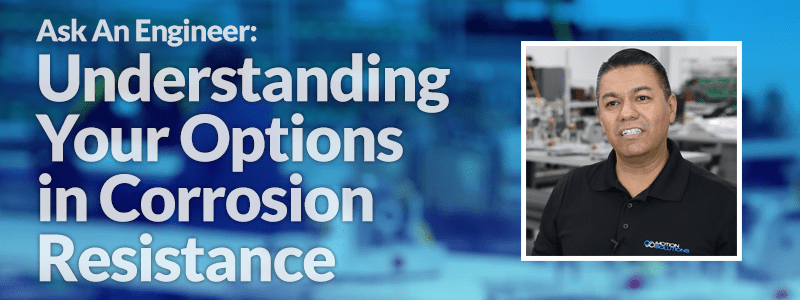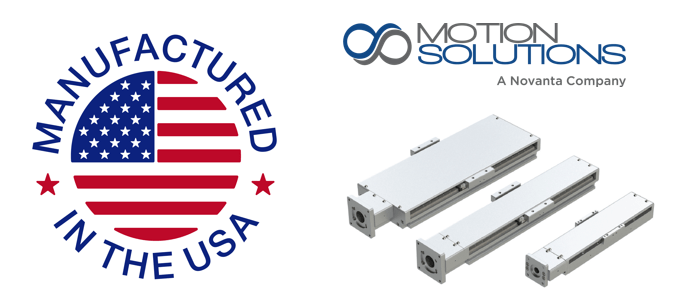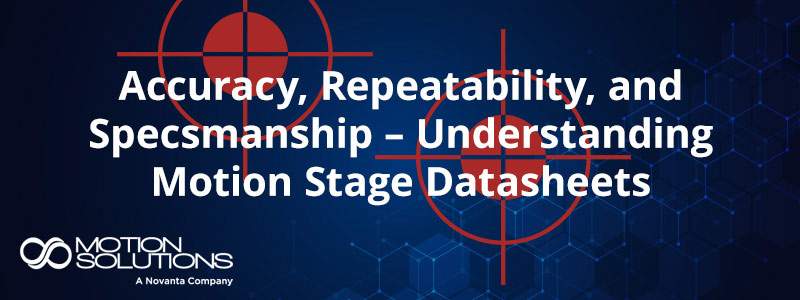Editor’s note: In this ongoing video series, members of the Motion Solutions engineering staff share insights on technologies and problem-solving. The Motion Solutions Engineered Solutions team works daily to design complex electromechanical assemblies across a variety of industries. With more than 300 years of aggregate design experience, they have deep expertise in designing customized bearings for a range of demanding applications.
Corrosion is an oxidation reaction that affects most metals. In the case of steel, the iron oxidizes when exposed to air and water to form rust, which can gradually destroy the material over time. The surfaces of steel linear bearings, for example, will degrade as a result of rust, increasing friction, contaminating the equipment and the environment, and reducing lifetime (see figure 1). Even seemingly benign surface corrosion can be a problem in consumer-facing applications. If the conditions of your application are likely to cause rust or are sensitive to rust, consider a treatment for corrosion resistance.

Corrosion can’t be stopped entirely. There are ways to slow the process, however. In this blog entry and video, we review some of the approaches to corrosion control, including the trade-offs involved.
Material matters
The default linear bearing material is carbon steel. It’s very hard, so it’s suitable for high loads. The problem is that it rusts. To mitigate this problem, manufacturers add chromium to make stainless steel. The chromium oxidizes to form an inert layer at the surface of the steel. This oxide layer helps prevent iron from diffusing the surface to form rust.
In addition to carbon steel, linear bearings can be made of martensitic (400 series) steel and austenitic (300 series) steel. Martensite has around 18% chromium but also higher levels of carbon. It is very hard but only moderately resistant to corrosion. Austenite has greater levels of chromium – as much as 26% – which lead to a thicker oxidation layer and higher oxidation resistance.
The trade-off for the increased corrosion resistance in austenitic linear bearings is reduced hardness. As a result, the dynamic and static load ratings of austenitic linear bearings are derated by about 80% and 85%, respectively. This isn’t necessarily a problem for lighter loads since we are still talking about load ratings in the hundreds of kilograms. In the case of heavier loads, increasing the number of blocks on each rail can help compensate for the derating.
Load ratings of martensitic linear bearings are the same as their carbon steel versions (no deration).
The biggest drawback with these two anti-corrosion options is that they can be quite a bit more expensive than carbon steel linear bearings. For budget-sensitive projects, a carbon-steel linear bearing treated with an anti-corrosion coating may be the best solution.
Anti-corrosion coatings
There are two classes of anti-corrosion coatings:
- Hard chrome plating
- Moderate corrosion resistance (equivalent to that of martensitic stainless steel)
- Hardness of 750 HV
- Less expensive than martensitic linear bearing
- Black chrome plating
- Very good corrosion resistance (equivalent to that of austenitic stainless steel)
- Significantly more expensive than hard chrome plating but less expensive than austenitic linear bearing
Making a decision on coatings requires trade-offs. A carbon steel linear bearing coated with hard chrome might be a good fit in moderate environment price-sensitive applications. For higher corrosion resistance, black chrome plated carbon steel offers corrosion resistance nearly equivalent to that of an austenitic linear bearing at a fraction of the price (see figure 2). For applications that require maximum lifetime, a black chrome coating over a martensitic linear bearing provides the highest possible protection.
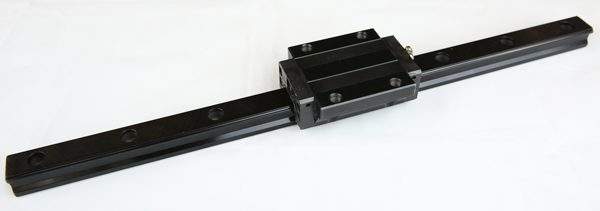
Execution matters
Anti-corrosion coatings can be effective solutions but there are key factors to be aware of. First, they are not stock items. When the factory gets an order, it doesn’t pull a pre-assembled linear bearing from the shelves to apply protection. Manufacturers typically build a new linear bearing from scratch, coating the rails and blocks prior to final assembly. Depending on the factory, this can add 10 weeks or more to the delivery time. For customers who can’t afford this type of leadtime, adding an anti-corrosion coating as an aftermarket item provides an alternative.
Coating a finished linear bearing can be challenging. The linear bearing needs to be disassembled, sent out for coating, and then reassembled after its return. This process sounds much easier than it is, especially for linear bearings that are expected to meet tolerances on the micron scale. Another problem is that the coating thickness changes the dimensions of the races. Reassembling the linear bearing with the original balls will destroy the coating in a very short period of time.
To address this problem while still reducing lead times, Motion Solution has the resources to provide after-market anti-corrosion coatings. We pull a precision stage from our warehouse, disassemble it, and send the rails and block to Armoloy for coating with their Armoloy TDC (thin dense chrome) plating (see figure 3). When we receive the finished items, our staff of expert technicians reassembles the linear bearings. We have an extensive inventory of balls in gradations of 1 µm, which enables us to install the exact right size to optimize performance and lifetime. The customer receives a qualified part that has been tested and approved for use.
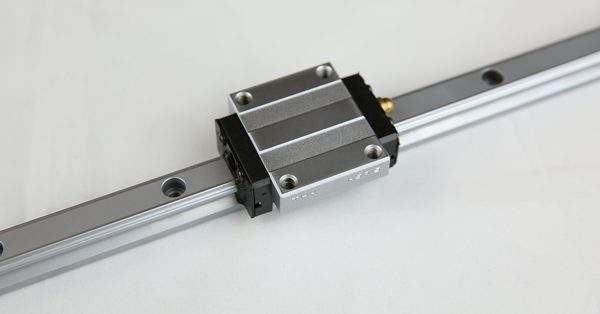
A final point worth mentioning is that all coatings have some variation in thickness across the part. As a result, a coated linear bearing may not meet the parallelism specifications of the base part. If your application has tight tolerances for parallelism but still presents risk of corrosion, it may be worth spending the extra money on an austenitic or martensitic linear bearing.
Corrosion protection is not a matter of choice. Oxidation is an ongoing process that will eventually limit the lifetime of your equipment. If the environmental factors of your application introduce a probability of rust and material damage, you need to decide on a strategy for dealing with it. Research the options and let our staff of in-house experts assist you in choosing the correct option for your application.
To learn more about anti-corrosion options, download the Special Environments white paper from our partner in precision linear bearings, THK.
Five Things to Know About Your Application Before Calling
- What are the loading conditions?
- What’s the environment like?
- What’s type of precision do you need?
- What’s your lead time?
- Are you budget sensitive?
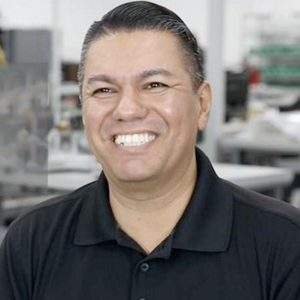
About the Author
Alex Polo is a Sales Engineer and linear motion specialist at Motion Solutions.

